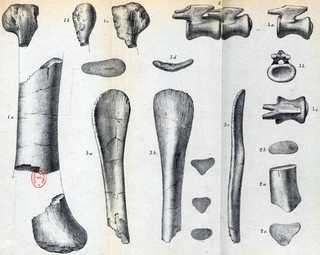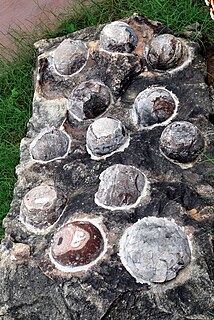| Medioolithus | |
|---|---|
| Egg fossil classification | |
| Basic shell type: | Ornithoid |
| Morphotype: | Ornithoid-ratite |
| Oofamily: | † Medioolithidae |
| Oogenus: | †Medioolithus |
| Oospecies | |
| |
Medioolithus is an oogenus of fossil egg laid by a paleognath. [1]
| Medioolithus | |
|---|---|
| Egg fossil classification | |
| Basic shell type: | Ornithoid |
| Morphotype: | Ornithoid-ratite |
| Oofamily: | † Medioolithidae |
| Oogenus: | †Medioolithus |
| Oospecies | |
| |
Medioolithus is an oogenus of fossil egg laid by a paleognath. [1]
Medioolithus is known several eggshell fragments, and one complete, spherical egg. M. geiseltalensis is very similar to modern ratite eggs, for example those of ostriches, rheas, and cassowaries. At 9 cm (3.5 in) in diameter, however, it is smaller than the eggs of any of these birds, being more similar in size to the egg of a kiwi. [1]

The chicken or the egg causality dilemma is commonly stated as the question, "which came first: the chicken or the egg?" The dilemma stems from the observation that all chickens hatch from eggs and all chicken eggs are laid by chickens. "Chicken-and-egg" is a metaphoric adjective describing situations where it is not clear which of two events should be considered the cause and which should be considered the effect, to express a scenario of infinite regress, or to express the difficulty of sequencing actions where each seems to depend on others being done first. Plutarch posed the question as a philosophical matter in his essay "The Symposiacs", written in the 1st century CE.

In some egg-laying animals, the egg tooth is a small, sharp, cranial protuberance used by offspring to break or tear through the egg's surface during hatching. It is present in most reptiles, and similar structures exist in monotremes, Eleutherodactyl frogs, and spiders.

An eggshell is the outer covering of a hard-shelled egg and of some forms of eggs with soft outer coats.

Hypselosaurus is a dubious titanosaurian sauropod that lived in southern France during the Late Cretaceous, approximately 70 million years ago in the early Maastrichtian. Hypselosaurus was first described in 1846, but was not formally named until 1869, when Phillip Matheron named it under the binomial Hypselosaurus priscus. The holotype specimen includes a partial hindlimb and a pair of caudal vertebrae, and two eggshell fragments were found alongside these bones. Because of the proximity of these eggshells to the fossil remains, many later authors, including Matheron and Paul Gervais, have assigned several eggs from the same region of France all to Hypselosaurus, although the variation and differences between these eggs suggest that they do not all belong to the same taxon. Hypselosaurus has been found in the same formation as the dromaeosaurids Variraptor and Pyroraptor, the ornithopod Rhabdodon, and the ankylosaurian Rhodanosaurus, as well as indeterminate bones from other groups.

Dinosaur eggs are the organic vessels in which a dinosaur embryo develops. When the first scientifically documented remains of dinosaurs were being described in England during the 1820s, it was presumed that dinosaurs had laid eggs because they were reptiles. In 1859, the first scientifically documented dinosaur egg fossils were discovered in France by Jean-Jacques Poech, although they were mistaken for giant bird eggs. The first scientifically recognized dinosaur egg fossils were discovered in 1923 by an American Museum of Natural History crew in Mongolia. Since then many new nesting sites have been found all over the world and a system of classification based on the structure of eggshell was developed in China before gradually diffusing into the West. Dinosaur eggshell can be studied in thin section and viewed under a microscope. The interior of a dinosaur egg can be studied using CAT scans or by gradually dissolving away the shell with acid. Sometimes the egg preserves the remains of the developing embryo inside. The oldest known dinosaur eggs and embryos are from Massospondylus, which lived during the Early Jurassic, about 190 million years ago.

Elongatoolithus is an oogenus of dinosaur eggs found in the Late Cretaceous formations of China and Mongolia. Like other elongatoolithids, they were laid by small theropods, and were cared for and incubated by their parents until hatching. They are often found in nests arranged in multiple layers of concentric rings. As its name suggests, Elongatoolithus was a highly elongated form of egg. It is historically significant for being among the first fossil eggs given a parataxonomic name.

Cairanoolithus is an oogenus of dinosaur egg which is found in Southwestern Europe. The eggs are large and spherical. Their outer surface is either smooth, or covered with a subdued pattern of ridges interspersed with pits and grooves. Multiple fossil egg clutches are known but the nest structure is unclear.
Continuoolithus is an oogenus of dinosaur egg found in the late Cretaceous of North America. It is most commonly known from the late Campanian of Alberta and Montana, but specimens have also been found dating to the older Santonian and the younger Maastrichtian. It was laid by an unknown type of theropod. These small eggs are similar to the eggs of oviraptorid dinosaurs, but have a distinctive type of ornamentation.
Sankofa is an oogenus of prismatoolithid egg. They are fairly small, smooth-shelled, and asymmetrical. Sankofa may represent the fossilized eggs of a transitional species between non-avian theropods and birds.

This timeline of egg fossils research is a chronologically ordered list of important discoveries, controversies of interpretation, taxonomic revisions, and cultural portrayals of egg fossils. Humans have encountered egg fossils for thousands of years. In Stone Age Mongolia, local peoples fashioned fossil dinosaur eggshell into jewelry. In the Americas, fossil eggs may have inspired Navajo creation myths about the human theft of a primordial water monster's egg. Nevertheless, the scientific study of fossil eggs began much later. As reptiles, dinosaurs were presumed to have laid eggs from the 1820s on, when their first scientifically documented remains were being described in England. In 1859, the first scientifically documented dinosaur egg fossils were discovered in southern France by a Catholic priest and amateur naturalist named Father Jean-Jacques Poech, however he thought they were laid by giant birds.

Egg paleopathology is the study of evidence for illness, injury, and deformity in fossilized eggs. A variety of pathological conditions afflicting eggs have been documented in the fossil record. Examples include eggshell of abnormal thickness and fossil eggs with multiple layers of eggshell. The identification of egg paleopathologies is complicated by the fact that even healthy eggs can be modified during or after fossilization. Paleontologists can use techniques like cathodoluminescence or thin sectioning to identify true paleopathologies in fossil eggs. Despite the diversity of paleopathologies known from fossil eggs, the vast majority of conditions known to afflict modern eggs have not yet been seen among fossils.
Reptile egg fossils are the fossilized remains of eggs laid by reptiles. The fossil record of reptile eggs goes back at least as far as the Early Permian. However, since the earliest reptile eggs probably had soft shells with little preservation potential, reptilian eggs may go back significantly farther than their fossil record. Many ancient reptile groups are known from egg fossils including crocodilians, dinosaurs, and turtles. Some ancient reptiles are known to have given live birth and are therefore not anticipated to have left behind egg fossils.
Parvoblongoolithus is an oogenus of fossil dinosaur egg whose small size and unusual shape suggest the possibility that it is a dwarf egg.
Guegoolithus is an oogenus of fossil egg from the early Cretaceous of Spain. It is classified in the oofamily Spheroolithidae, and was probably laid by an ornithopod dinosaur.
Undulatoolithus is an oogenus of Chinese fossil dinosaur egg belonging to Elongatoolithidae. It is very similar to Macroolithus, but has different ornamentation. Like other elongatoolithids, it was probably laid by oviraptorosaurs.
Tubercuoolithus is an oogenus of dinosaur egg from the early Campanian of Montana.
Triprismatoolithus is an oogenus of dinosaur egg native to Teton County, Montana. It is classified in the oofamily Arriagadoolithidae, the eggs of alvarezsaurs.
Incognitoolithus is an oogenus of medioolithid fossil bird egg. It is notable for bearing evidence of predation, possibly from a bird pecking the eggshell.

Gobioolithus is an oogenus of fossil bird egg native to Mongolia. They are small, smooth-shelled, and elongated eggs that were first discovered in the 1960s and early 70s during a series of fossil-hunting expeditions in the Gobi desert. Two oospecies have been described: Gobioolithus minor and G. major. The eggs were probably laid in colonial nesting sites on the banks of rivers and lakes.
Nanhsiungoolithus is an oogenus of dinosaur egg from the late Cretaceous of China. It belongs to the oofamily Elongatoolithidae, which means that it was probably laid by an oviraptorosaur, though so far no skeletal remains have been discovered in association with Nanhsiungoolithus. The oogenus contains only a single described oospecies, N. chuetienensis. It is fairly rare, only being know from two partially preserved nests and a few eggshell fragments.